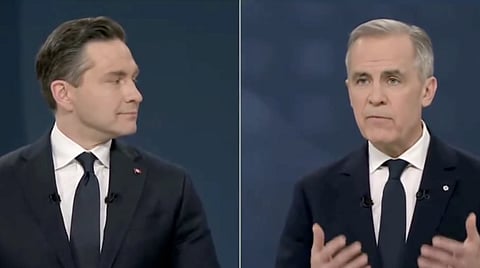

So the choice comes down to this.
Liberal Mark Carney wants us to be better people, according to his definition of a woke, net-zero Canada, and he would also like us to pay for the privilege of self-improvement through taxes and inflation. His plan is simple, if you cannot afford fuel, you will not generate carbon dioxide and Canada under Mr. Carney's inspired leadership will have shown the world how to save itself from global warming.
And that is what would make you a better person.
Conservative Pierre Poilievre on the other hand, doesn't so much want to make the people better; he wants to make life better for people.
How? Through his 'Plan for Change,' his goal is to save us money through lower taxes. Mr. Poilievre's plan further involves tackling the deficit, bringing down prices, turning the market loose in a reduced tax environment to build homes for the many people who desperately need them — and then keeping their neighbourhoods safe by enforcing public safety.
And that is what a better life would look like.
It really couldn't be any clearer, could it?
Mr. Carney's celestial greatness at your expense, or Mr. Poilievre's practical plan to make your life great.
Three points, then.
First, don't buy the superiority of the 'central banker who understands the world' narrative.
On Saturday, Mr. Carney showed us his costed platform, the centrepiece of which was his intention to borrow another $200 billion over four years, $130 billion in year one.
Let that sink in.
$225 billion more in debt.
This would be on top of the $600 billion that his predecessor Justin Trudeau borrowed between 2015 and 2024, thereby doubling a deficit of $600 billion accumulated over the previous 148 years to $1.2 trillion. Significantly, it appears that was all done with Mr. Carney's banker advice and approval.
Also upon Mr. Carney's advice, a carbon tax has been levied for the last four years.
The result? Inflation, inflation and more inflation. People in Ontario who could manage ten years ago, now go to food banks. Half of Albertans are $200 a month from not being able to handle the bills.
So now, another $225 billion on top of all that, so that Mr. Carney can increase government spending by $130 billion in the first year alone.
The rest would be borrowed and spent — Mr. Carney prefers to say 'invested' — over the following three years.
Such is his promise to Canadians.
Amazingly, he's even making his predecessor look good. According to the most recent Fall Economic Statement, Mr. Trudeau was planning to borrow $100 billion less over the same period. Just the debt charges will be a further $5.6 billion more than Trudeau's plan. Altogether, interest charges already cost taxpayers more than $1 billion per week.
Second, while Mr. Poilievre's costed plan still calls for borrowing, it's a lot less — $34 billion over four years, as opposed to Mr. Carney's $225 billion — and includes a pledge to cut the deficit by 70 percent.
This is ambitious. Going cold turkey on debt reduction after nearly ten years of insouciant Liberal spending decisions is virtually impossible. (In Canada. Not so in the US, we note with approval.)
But Mr. Poilievre's plan also promises to cut $75 billion in taxes over four years, funded by spending reductions. That is at least a logical connection between intention and operation.
Indeed, the Conservative connection between unlocking resources to build homes and accelerate infrastructure projects liberates the private sector to do what, far more than the bureaucracies Mr. Carney lovingly contemplates, the private sector is best equipped to achieve.
Third, these two approaches, the Liberal and the Conservative are ciphers for the national mood.
Do Canadians want a government that for its legitimacy requires Canadians to be fearful — fearful of Donald Trump, of uncertainty, even of sunshine itself? Or, will Canadians choose a government that challenges them to be ambitious, to take the initiative for their own good and then liberates them to do it?
Two plans, two future possibilities... it really isn't usually this clear, is it?
